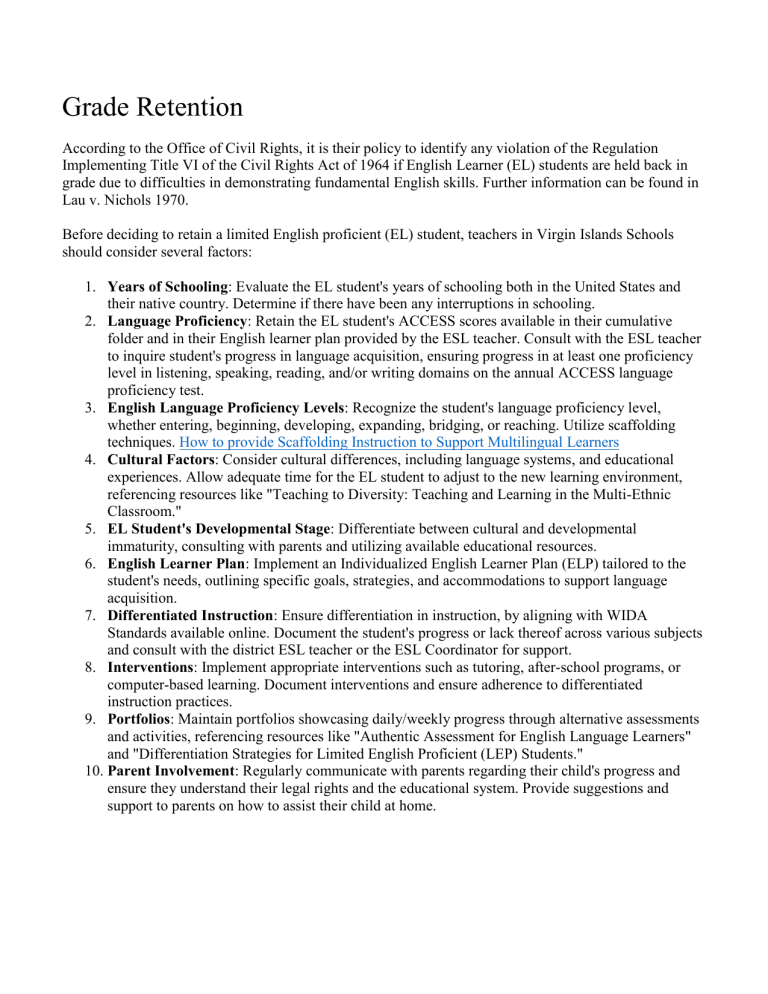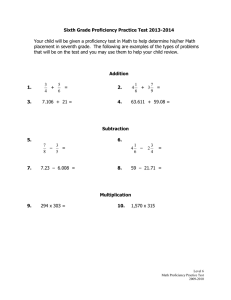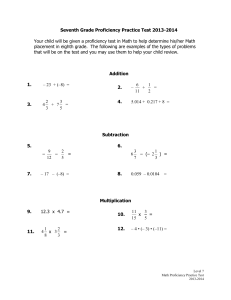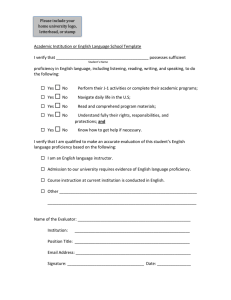
Grade Retention According to the Office of Civil Rights, it is their policy to identify any violation of the Regulation Implementing Title VI of the Civil Rights Act of 1964 if English Learner (EL) students are held back in grade due to difficulties in demonstrating fundamental English skills. Further information can be found in Lau v. Nichols 1970. Before deciding to retain a limited English proficient (EL) student, teachers in Virgin Islands Schools should consider several factors: 1. Years of Schooling: Evaluate the EL student's years of schooling both in the United States and their native country. Determine if there have been any interruptions in schooling. 2. Language Proficiency: Retain the EL student's ACCESS scores available in their cumulative folder and in their English learner plan provided by the ESL teacher. Consult with the ESL teacher to inquire student's progress in language acquisition, ensuring progress in at least one proficiency level in listening, speaking, reading, and/or writing domains on the annual ACCESS language proficiency test. 3. English Language Proficiency Levels: Recognize the student's language proficiency level, whether entering, beginning, developing, expanding, bridging, or reaching. Utilize scaffolding techniques. How to provide Scaffolding Instruction to Support Multilingual Learners 4. Cultural Factors: Consider cultural differences, including language systems, and educational experiences. Allow adequate time for the EL student to adjust to the new learning environment, referencing resources like "Teaching to Diversity: Teaching and Learning in the Multi-Ethnic Classroom." 5. EL Student's Developmental Stage: Differentiate between cultural and developmental immaturity, consulting with parents and utilizing available educational resources. 6. English Learner Plan: Implement an Individualized English Learner Plan (ELP) tailored to the student's needs, outlining specific goals, strategies, and accommodations to support language acquisition. 7. Differentiated Instruction: Ensure differentiation in instruction, by aligning with WIDA Standards available online. Document the student's progress or lack thereof across various subjects and consult with the district ESL teacher or the ESL Coordinator for support. 8. Interventions: Implement appropriate interventions such as tutoring, after-school programs, or computer-based learning. Document interventions and ensure adherence to differentiated instruction practices. 9. Portfolios: Maintain portfolios showcasing daily/weekly progress through alternative assessments and activities, referencing resources like "Authentic Assessment for English Language Learners" and "Differentiation Strategies for Limited English Proficient (LEP) Students." 10. Parent Involvement: Regularly communicate with parents regarding their child's progress and ensure they understand their legal rights and the educational system. Provide suggestions and support to parents on how to assist their child at home. Common Myths about Retaining ELs Misconception #1: Keeping an English Learner (EL) back will aid their language development. It's important to reconsider the notion of retention as a means to enhance English proficiency. Rather than viewing it as an extra year for language acquisition, it should be recognized as a setback. Referencing the landmark Supreme Court case Lau v. Nichols (1974), it's evident that retaining an EL solely due to language barriers is discriminatory. (Refer to this brief video overview of Lau v. Nichols from Colorin Colorado.) Misconception #2: Delaying a student due to lack of English proficiency is justified. English proficiency shouldn't be equated with cognitive ability. Imagine relocating to a new country where you're not fluent in the language; your intelligence remains intact. With appropriate support, students can grasp English alongside their academic subjects. While conversational language might be acquired within one to three years, mastering academic language could take four to seven years (Echevarria, Vogt, Short, 2017). Misconception #3: Holding back an EL will benefit their future. Research by John Hattie (2016) reveals that retention yields adverse outcomes. Instead of fostering success, it tends to hinder progress. Repeating the same grade level and curriculum can lead to disillusionment and decreased motivation among students. It's crucial to examine states with smaller disparities or where ELs outperform their peers. Remember Retention of ELs shall not be based on the level of English language proficiency. We have laid out the guidelines administrators and teachers must follow to ensure that fair practice is taking place and consideration of ELs' language proficiency is not being discriminated against. If your school has English learners but does not have and ESOL teacher, you may not retain the EL because that student has not received appropriate services because of the lack of ESOL services. The Virgin Islands EL Policy and Procedures Manual, pages 25-26, found at https://goopenusvi.vide.vi/hubs/ESOL , provides a clear path when considering retention. If you have any questions, don't hesitate to contact your district Language Acquisition Coordinator or the State Office of Bilingual Education.




